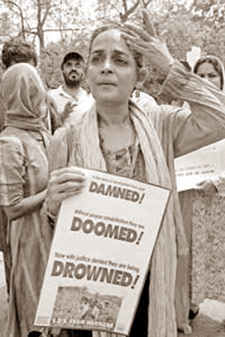Women in India: A long way to go
 India
got its first woman prime minister, Indira Gandhi, 40 years ago and its
first woman President, Pratibha Patil, this year. But theirs is not the
story of the common Indian woman. The past 60 years are a story of
missed opportunities.... where despite a legal framework, women have
been reined in by a rigid, patriarchal society. India
got its first woman prime minister, Indira Gandhi, 40 years ago and its
first woman President, Pratibha Patil, this year. But theirs is not the
story of the common Indian woman. The past 60 years are a story of
missed opportunities.... where despite a legal framework, women have
been reined in by a rigid, patriarchal society.
Around 245 million Indian women cannot read or write making up the
world's largest number of illiterate women in a single country. The sex
ratio of 933 females per 1,000 males is one of the worst in the world.
And women make up only four per cent of the organised workforce.
The progress of women in India, a largely patriarchal society, has at
worst been slow and at best steady though the government says the
picture is not all dismal.
"Since Independence, the condition of women in the country has
changed to a significant extent," National Commission for Women (NCW)
chairperson Girija Vyas said. "Not only Pratibha Patil but also women
working as heads of local bodies in villages and remote areas have
brought respect and glory to the women community," she said.
 Vyas
is not wrong. The Indian constitution guarantees women equality of
opportunity and wage and disallows gender bias by the state. The 73rd
amendment, providing for 33 per cent reservation for women in Panchayati
Raj institutions, has brought more than a million women into active
grassroots politics. Vyas
is not wrong. The Indian constitution guarantees women equality of
opportunity and wage and disallows gender bias by the state. The 73rd
amendment, providing for 33 per cent reservation for women in Panchayati
Raj institutions, has brought more than a million women into active
grassroots politics.
Local women the vast majority of them illiterate and poor have come
to occupy as much as 43 per cent of the seats at the village and
district and other civic bodies.
If the female literacy rate in 1951, shortly after independence, was
only seven per cent as against 25 per cent for males it has risen to
54.16 per cent now. The male literacy rate, according to the 2001
census, is 75.85 per cent.
"In the post-Independence era, with the help of social reformers and
strong women's movements, the Indian woman has started recognising her
true potential," said Annie Raja, general secretary of the National
Federation of Indian Women.
The Indian woman has started questioning the rules laid down for her
by society, has begun breaking barriers and there are shining examples
of those who have excelled in various fields from Sania Mirza in sports
and Kiran Mazumdar Shaw in business to Mayawati in politics and
Arundhati Roy in literature.
Raja feels this was possible because of "the strong intervention of
women organisations and movements in the country". But that is only a
part of the picture. The fact is that policy-making bodies still do not
have a significant presence of women. Their representation in the Indian
parliament and state legislatures is not more than 10 per cent.
So far Indian lawmakers have been unable to agree on a proposed law
for one-third quota for women in parliament and legislatures. "But we
have managed to put the women quota as a part of every major political
party's manifesto.
Although the women development is not in the same pace as that of the
country's development, things are happening," Raja said.
Vyas agreed with Raja. "Though women are scaling new heights, a lot
of work still has to be done for their uplift and overall development.
Women are still struggling to create a niche in a male-dominated
society." Dowry deaths and rape cases are still reported daily, even
from metropolises, and the sex ratio is skewed against them. India's
maternal mortality is the second highest in the world.
According to the British journal The Lancet , more than 10 million
girls in India have gone "missing" due to sex selection and abortion in
the last one decade; this despite the government having banned foetal
sex selection technologies in 1994.
Two-thirds of deliveries still take place at home, with only 43 per
cent supervised by health professionals.
Leading women's activist Mohini Giri said: "The biggest challenge
Indian women face is the inequality in education, health and employment
opportunities and social stigmas." "The law itself is not enough in this
male-dominated society. If we want to make real changes there has to be
awareness. People in power should ensure effective implementation of the
law," Giri said.
The last 60 years of independence have brought positive change for
women.
Pictures of young girls in school uniforms cheerfully going to school
are not at all uncommon. But India's first Prime Minister Jawaharlal
Nehru's words still linger, "You can tell the condition of a nation by
looking at the status of its women."
(Khaleej Times)
|
